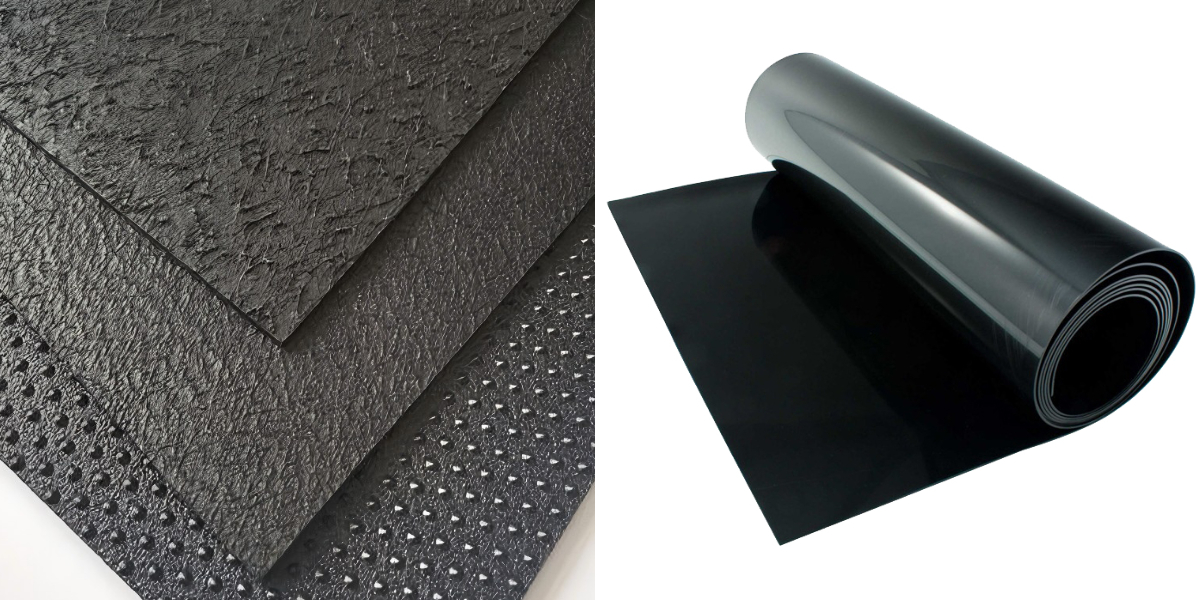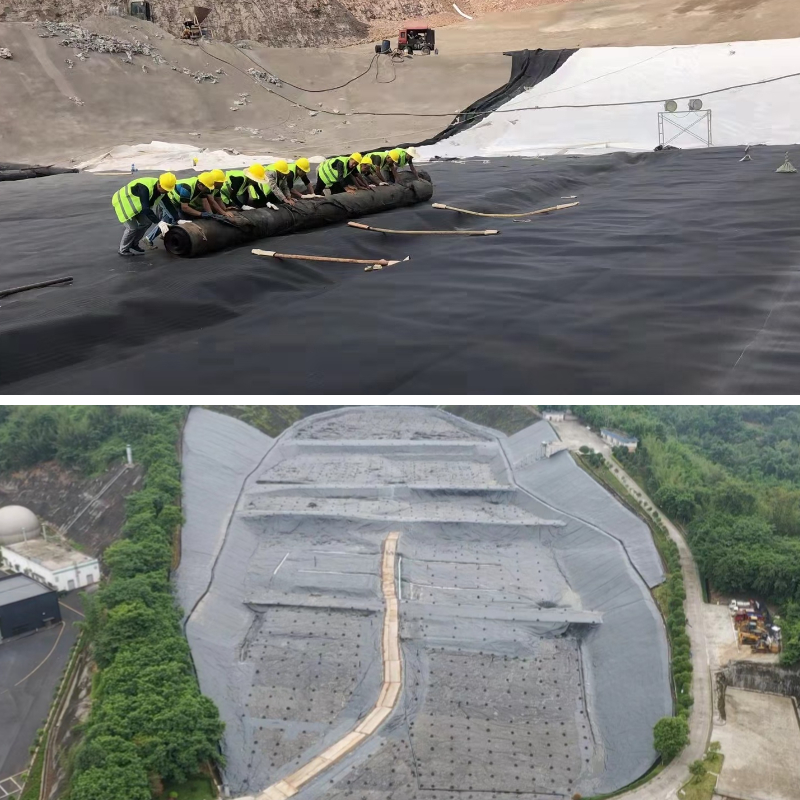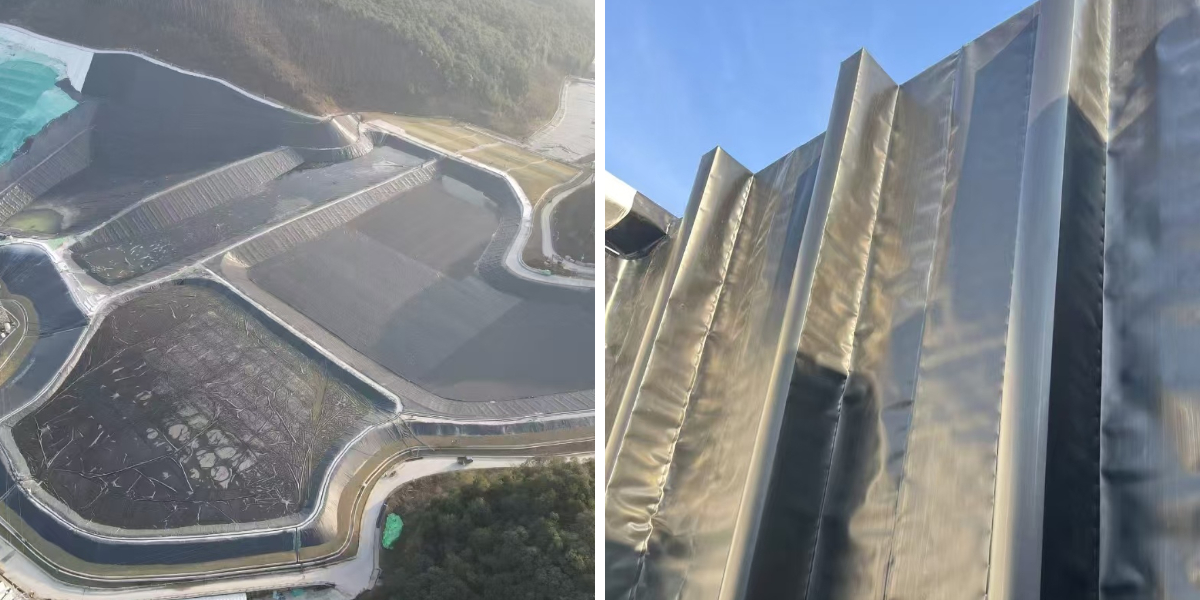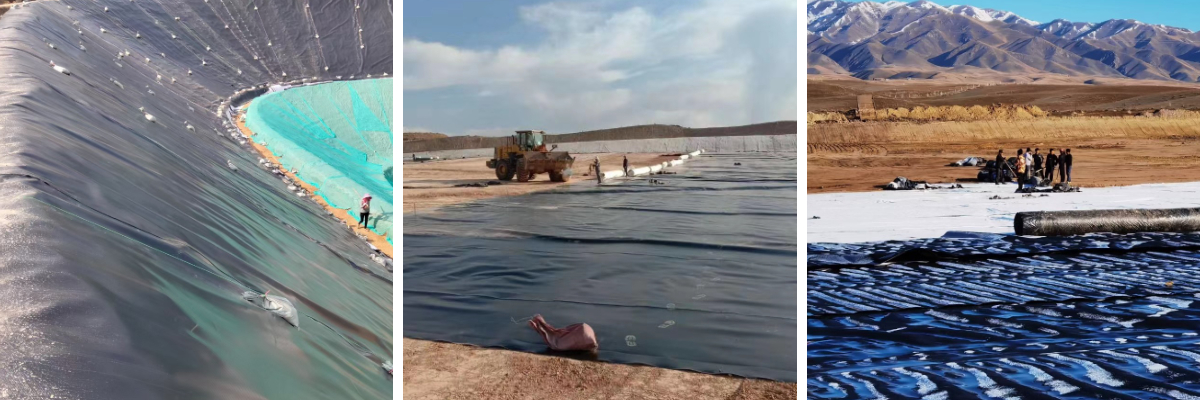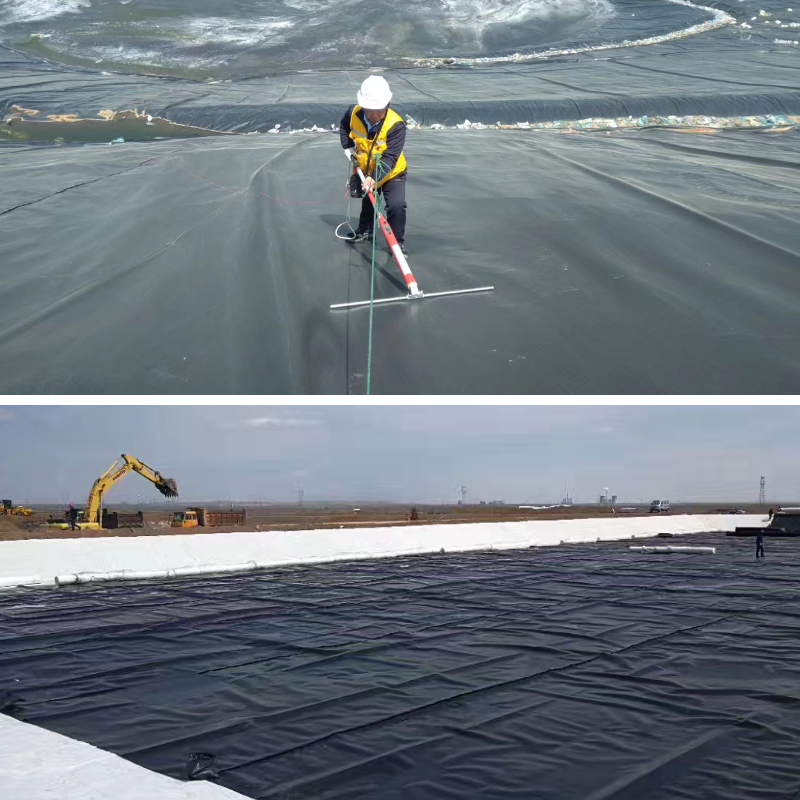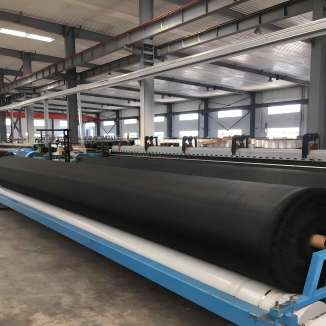Geomembranes in Solar Pond Projects: Renewable Energy Applications
In the quest for sustainable and smooth power sources, photo voltaic ponds have emerged as a promising answer inside the realm of renewable energy. As the international demand for power continues to surge whilst worries over environmental influence and fossil - gas depletion grow, the significance of renewable strength has by no means been extra significant. Solar ponds provide a special and environment friendly way to harness the sun's energy, which is now not solely plentiful however additionally smooth and free.
The Concept and Working Principle of Solar Ponds
A photo voltaic pond is a physique of water that is designed to gather and keep photo voltaic strength in the shape of heat. It features based totally on the precept of a non - convective, stratified water body. The photo voltaic pond normally consists of three predominant layers: the higher convective layer, the non - convective salt - gradient layer, and the decrease convective layer.
The top convective layer is the pinnacle - most section of the photo voltaic pond, which is fairly skinny and has a low salt concentration. Sunlight penetrates this layer and warms the water. However, due to its low salt content, this layer is challenge to convective warmness transfer. That is, the heat water at the floor tends to combine with the cooler water below, which would usually dissipate the heat.
Beneath the top convective layer lies the non - convective salt - gradient layer. This layer is the key to the photo voltaic pond's electricity - storage mechanism. It has a progressively growing salt attention from pinnacle to bottom. The density gradient created via the various salt concentrations in this layer inhibits convection. As a result, warmth electricity absorbed with the aid of the decrease layers of the pond can't get away without problems via convection. This trapped warmness accumulates over time in the decrease convective layer, which is the backside layer of the photo voltaic pond. The decrease convective layer has a excessive salt awareness and can shop a giant quantity of heat, which can be utilized for a variety of applications.
Significance of Solar Ponds in the Renewable Energy Landscape
Solar ponds play a critical function in the renewable electricity portfolio for various reasons. Firstly, they are a dependable supply of thermal energy. The saved warmness in the photo voltaic pond can be used for a range of purposes, such as house heating for buildings, industrial system heating, and even electrical energy era thru a Rankine cycle or different warmness - to - energy conversion systems. This makes photo voltaic ponds appropriate for each small - scale and massive - scale strength applications.
Secondly, photo voltaic ponds have a notably low environmental have an effect on in contrast to fossil - gasoline - based totally power sources. They do now not emit greenhouse gases all through operation, contributing to the discount of carbon emissions and the mitigation of local weather change. Additionally, they do now not produce air pollution such as sulfur dioxide, nitrogen oxides, or particulate matter, which are hazardous to human fitness and the environment.
Moreover, photo voltaic ponds can be built in a huge vary of geographical locations, as lengthy as there is adequate sunlight. This makes them reachable to many areas round the world, regardless of their proximity to common power resources. They can additionally be built-in with current water our bodies or constructed on marginal lands, minimizing the want for giant - scale land acquisition.
The Crucial Role of Geomembranes in Solar Ponds
Geomembranes, such as HDPE (High - Density Polyethylene) membranes and HDPE liner sheets, are vital aspects in the building and operation of photo voltaic ponds. These substances act as a barrier to forestall water seepage from the photo voltaic pond into the surrounding soil. Seepage can now not solely lead to a loss of water in the photo voltaic pond however additionally motive harm to the underlying soil and close by constructions due to the motion of water - borne salts.
HDPE membranes, in particular, are rather resistant to chemicals, UV radiation, and organic degradation. They have a excessive tensile electricity and flexibility, which approves them to stand up to the stresses and traces related with the development and operation of the photo voltaic pond. HDPE liner sheets are specially designed to grant a clean and impermeable floor for the pond, making sure that the water stays inside the pond and the salt - gradient layer is maintained. The use of geomembranes in photo voltaic ponds helps to enhance the normal effectivity and durability of the photo voltaic pond system, making it a greater possible and value - high quality renewable strength solution.
The Crucial Role of Geomembranes
2.1 Barrier Function
Geomembranes, specifically HDPE membranes, play a vital function as a barrier in photo voltaic pond projects. In a photo voltaic pond, water containment is of utmost importance. HDPE membranes have an extraordinarily low permeability, which efficaciously prevents water from seeping out of the pond. This is indispensable due to the fact any loss of water can disrupt the salt - gradient layer that is fundamental for the photo voltaic pond's strength - storage mechanism.
For instance, in a massive - scale photo voltaic pond project, if water seepage occurs, the salt - gradient layer might also be diluted or even totally destroyed. This would lead to the breakdown of the non - convective layer, and warmness would be misplaced via convection, decreasing the usual effectivity of the photo voltaic pond. The water resistant and anti - seepage homes of HDPE membranes make sure that the water stays inside the pond, keeping the integrity of the salt - gradient layer.
Moreover, geomembranes additionally act as a barrier towards the migration of chemical substances. In some cases, the water in the photo voltaic pond may additionally comprise sure salts or different chemical components. HDPE membranes stop these chemical compounds from leaching into the surrounding soil, defending the soil's chemical and bodily properties. This now not solely safeguards the surroundings round the photo voltaic pond however additionally helps in preserving the lengthy - time period steadiness of the photo voltaic pond structure.
2.2 Structural Support
In addition to their barrier function, geomembranes supply considerable structural guide to photo voltaic ponds. HDPE liner sheets, with their excessive - power and sturdiness characteristics, are necessary in this regard. The liner sheets are laid at the backside and aspects of the photo voltaic pond, growing a secure base for the water body.
The excessive tensile electricity of HDPE liner sheets lets in them to face up to the stress exerted via the water in the photo voltaic pond. As the photo voltaic pond fills with water, the weight of the water can motive vast stress on the pond's structure. HDPE liner sheets can face up to this stress barring tearing or deforming, making sure the balance of the pond.
Furthermore, for the duration of the development of the photo voltaic pond, the HDPE liner sheets can assist distribute the load evenly. They can bridge over small irregularities or susceptible factors in the underlying soil, stopping the formation of sinkholes or different structural failures. This is mainly vital in areas the place the soil prerequisites may additionally be much less than ideal. For example, in areas with smooth or free soil, the HDPE liner sheets can supply the critical reinforcement to help the weight of the photo voltaic pond and its contents. Over time, the sturdiness of the HDPE liner sheets ensures that the structural guide they supply stays consistent, contributing to the lengthy - time period viability of the photo voltaic pond.
Types of Geomembranes Used in Solar Pond Projects
3.1 HDPE Membrane
HDPE membranes are the most frequently used geomembranes in photo voltaic pond projects. HDPE, or High - Density Polyethylene, is a thermoplastic resin with a excessive diploma of crystallinity and non - polarity. These membranes are characterised by using various amazing homes that make them perfect for photo voltaic pond applications.
One of the key aspects of HDPE membranes is their brilliant chemical resistance. They can face up to publicity to a vast vary of chemicals, along with the salts existing in the photo voltaic pond water. This resistance ensures that the membrane does now not degrade or corrode over time, preserving its integrity and functionality. For example, in a photo voltaic pond with a excessive - salt - awareness decrease convective layer, the HDPE membrane can stop the salts from chemically attacking the material, making sure lengthy - time period performance.
HDPE membranes additionally have great UV resistance. Although photo voltaic ponds are crammed with water, the higher components of the geomembrane might also nonetheless be uncovered to daylight at some stage in building or in case of water - degree fluctuations. The capability of HDPE membranes to face up to UV radiation potential they can keep their bodily and mechanical houses over many years of publicity to sunlight. This UV resistance is necessary for the lengthy - time period sturdiness of the photo voltaic pond, as a degraded membrane ought to lead to water seepage and a loss of the photo voltaic pond's strength - storage capabilities.
Another essential property of HDPE membranes is their desirable flexibility. Despite being a robust and long lasting material, HDPE membranes can conform to the structure of the photo voltaic pond's foundation, whether or not it is flat or has some irregularities. This flexibility approves for convenient installation, as the membrane can be laid out and adjusted to suit the particular contours of the pond site. It additionally permits the membrane to face up to minor moves in the underlying soil besides cracking or tearing, which is fundamental for the long - time period steadiness of the photo voltaic pond structure. Due to these blended properties, HDPE membranes are broadly used in photo voltaic pond initiatives round the world, offering a dependable and fee - high quality answer for water containment and barrier protection.
3.2 Other Geomembranes
While HDPE membranes are the most usual in photo voltaic pond projects, different sorts of geomembranes additionally discover functions in positive situations.
Low - Density Polyethylene (LDPE) membranes, for example, have a decrease density in contrast to HDPE membranes. LDPE is greater bendy than HDPE, which can be an benefit in some purposes the place intense flexibility is required, such as in ponds with incredibly irregular shapes or in areas with good sized floor movement. However, LDPE has a decrease tensile energy and is much less chemically resistant than HDPE. In a photo voltaic pond, the notably decrease chemical resistance of LDPE can also make it extra inclined to degradation from the salts and different chemical factors in the pond water over time. As a result, LDPE membranes are now not as frequently used as HDPE membranes in photo voltaic pond tasks however may additionally be viewed in precise instances the place their special flexibility is a quintessential factor.
Ethylene - Propylene - Diene Monomer (EPDM) geomembranes are every other option. EPDM is a artificial rubber - primarily based material. EPDM geomembranes provide remarkable resistance to weathering, ozone, and UV radiation. They additionally have appropriate flexibility and can be effortlessly bonded together. However, EPDM membranes are typically extra high priced than HDPE membranes, which limits their large use in photo voltaic pond projects. EPDM may also be chosen for photo voltaic ponds in areas with very harsh environmental conditions, such as excessive - altitude areas with excessive UV radiation or areas with a excessive ozone concentration, the place its most effective weathering resistance can justify the greater cost.
Installation and Maintenance of Geomembranes
4.1 Installation Process
The ideal set up of geomembranes is critical for the lengthy - time period overall performance and effectivity of photo voltaic pond projects. Before installation, thorough website online guidance is essential. The vicinity the place the photo voltaic pond will be built need to be cleared of any debris, rocks, or vegetation that may want to doubtlessly puncture or harm the geomembrane. The soil floor have to be graded and compacted to supply a clean and steady base. Any irregularities in the floor can motive stress factors on the geomembrane, main to untimely failure.
When it comes to the true laying of the geomembrane, care ought to be taken to make certain a desirable fit. HDPE liner sheets are generally unrolled and unfold out throughout the organized site. It is vital to unroll the sheets in a way that minimizes wrinkles and folds. In giant - scale photo voltaic pond projects, mechanical gear such as tractors or rollers might also be used to aid in the laying method for massive - structure geomembranes, while smaller areas can be mounted manually.
During the laying process, the overlap between adjoining geomembrane sheets is a necessary aspect. The overlap width is typically special in the venture design, however a frequent wellknown is round 10 - 15 centimeters. This overlap ensures that there is adequate fabric for a robust and dependable bond throughout the welding process. The edges of the overlapping geomembrane sheets ought to be cautiously aligned to make sure a uniform overlap.
Welding is the key approach for becoming a member of geomembrane sheets collectively to shape a continuous, impermeable barrier. Hot - wedge welding is a extensively used technique for HDPE membranes. In this process, the overlapping edges of the geomembranes are heated the usage of a warm - wedge welding machine. The warmth reasons the polymer fabric of the HDPE membranes to melt. Once the cloth is in a semi - molten state, strain is utilized to fuse the two layers together. The welding speed, temperature, and strain settings are cautiously adjusted based totally on the thickness of the geomembrane and the environmental prerequisites at the set up site. For example, in chillier weather, greater welding temperatures can also be required to make certain suitable melting of the HDPE material.
Another vital consideration all through welding is the satisfactory of the weld. Weld seams need to be inspected visually for any signs and symptoms of defects, such as incomplete fusion, holes, or irregularities. Non - negative trying out methods, such as air - stress testing, can additionally be used to affirm the integrity of the welds. In air - strain testing, air is pumped into the area between the two welded layers of the geomembrane. If the weld is sound, the air strain will stay secure over a precise period. If there is a leak, the stress will drop, indicating a want for re - welding or repair.
4.2 Maintenance Considerations
Regular protection of geomembranes in photo voltaic ponds is necessary to make certain their persisted effectiveness and longevity. One of the key factors of renovation is normal inspection. Inspections must be carried out at least as soon as a year, however greater normal tests may also be quintessential in areas with excessive environmental stipulations or excessive - site visitors areas round the photo voltaic pond. During inspections, the whole floor of the geomembrane ought to be visually examined for any signs and symptoms of damage. This consists of searching for punctures, tears, cracks, or areas the place the geomembrane may also have been lifted or separated from the underlying soil. Particular interest need to be paid to the weld seams, as these are the most susceptible areas for plausible leaks.
Cleaning the geomembrane is every other vital protection task. Over time, debris, dirt, and algae can accumulate on the floor of the geomembrane. This no longer solely influences the look of the photo voltaic pond however can additionally doubtlessly injury the geomembrane. Algae growth, for example, can entice moisture in opposition to the membrane, main to degradation. To easy the geomembrane, a tender - bristle brush and a mild, non - abrasive cleaner can be used. Harsh chemical substances must be avoided, as they can injury the polymer cloth of the HDPE membrane. In some cases, a low - stress water spray can additionally be used to rinse away free debris.
If any injury is detected throughout the inspection, instantaneous restore is necessary. Small punctures or tears can regularly be repaired the usage of a patch. The broken location need to first be cleaned completely to cast off any dust or debris. A patch of the equal geomembrane material, barely large than the broken area, is then cut. The edges of the patch and the broken place are heated the usage of a warm - air gun or a small - scale welding tool. Once the substances are melted, the patch is pressed firmly onto the broken vicinity and held in region till the fabric cools and re - solidifies. Larger areas of harm can also require extra substantial repairs, such as changing a area of the geomembrane. In such cases, the broken area is cautiously removed, and a new piece of geomembrane is hooked up and welded in place, following the equal set up and welding techniques as for the duration of the preliminary construction.
In addition to bodily inspections and repairs, it is additionally essential to screen the environmental prerequisites round the photo voltaic pond. Changes in temperature, humidity, and soil prerequisites can all have an effect on the overall performance of the geomembrane. For example, excessive temperature fluctuations can reason the geomembrane to extend and contract, probably main to stress cracks. If big modifications in the surrounding surroundings are detected, gorgeous measures have to be taken to shield the geomembrane, such as including extra insulation or adjusting the water - degree administration in the photo voltaic pond. By following these upkeep procedures, the geomembrane in a photo voltaic pond can proceed to characteristic efficiently for many years, contributing to the usual success of the renewable electricity project.
Case Studies of Successful Solar Pond Projects
5.1 Project A
In a photo voltaic pond task placed in a semi - arid region, the use of HDPE membranes was once imperative to its success. The mission aimed to supply thermal power for a close by agricultural facility, in general for greenhouse heating all through the less warm months.
The photo voltaic pond was once developed with a giant - location HDPE membrane as the liner. The set up technique was once cautiously executed, with a focal point on making sure a seamless and leak - proof barrier. The HDPE membrane's tremendous chemical resistance used to be put to the check as the pond water had a pretty excessive salt content material due to the neighborhood water source. Over the years of operation, the HDPE membrane confirmed no signs and symptoms of degradation from the salts in the water.
The use of the HDPE membrane in this challenge introduced big financial benefits. By stopping water seepage, the photo voltaic pond was once capable to keep its water degree and the integrity of the salt - gradient layer. This led to steady warmness storage and environment friendly power production. The agricultural facility saved a widespread quantity of cash on typical heating fuels, such as herbal gas. The secure overall performance of the photo voltaic pond, thanks to the dependable HDPE membrane, additionally decreased the want for regular preservation and repairs, similarly reducing down on costs.
5.2 Project B
Another incredible photo voltaic pond assignment used to be carried out in a coastal area. This mission used to be extra complicated as it had to face up to the harsh coastal environment, along with excessive humidity, sturdy winds, and publicity to salt - encumbered air in addition to the ordinary challenges of a photo voltaic pond.
A excessive - pleasant HDPE membrane was once chosen for its UV resistance and durability. During installation, more precautions have been taken to defend the membrane from viable injury all through the building process, which worried dealing with the uneven coastal terrain. The overlapping seams of the HDPE liner sheets had been welded with gorgeous precision, and thorough satisfactory manage measures have been carried out to make certain the integrity of the welds.
In phrases of environmental impact, the use of the HDPE membrane in this photo voltaic pond assignment was once a high-quality step. The photo voltaic pond supplied smooth thermal electricity for a nearby neighborhood center, decreasing the center's reliance on fossil - gasoline - based totally heating systems. This, in turn, diminished the carbon footprint of the neighborhood center. The HDPE membrane additionally contributed to the typical environmental safety by using stopping the leaching of any probably dangerous resources from the photo voltaic pond into the surrounding coastal ecosystem. The project's success tested that geomembranes like HDPE membranes can be correctly used in difficult environments to assist renewable power initiatives and obtain each monetary and environmental benefits.
Challenges and Solutions in Geomembrane Application
6.1 Challenges
Despite the severa blessings and great use of geomembranes in photo voltaic pond projects, their utility is no longer barring challenges. One of the important challenges is the have an impact on of excessive local weather conditions. In areas with excessive - temperature climates, photo voltaic ponds can be uncovered to excessive daylight and improved temperatures for prolonged periods. High temperatures can speed up the growing old manner of geomembranes, specially HDPE membranes. The warmth can purpose the polymer chains in the HDPE fabric to damage down, main to a loss of mechanical residences such as tensile power and flexibility. This degradation can enlarge the hazard of the geomembrane creating cracks or tears, which in flip can lead to water seepage and a loss of the solar pond's electricity - storage capabilities.
In addition to excessive - temperature challenges, low - temperature environments additionally pose problems. In bloodless regions, the geomembrane can emerge as brittle at low temperatures. When the temperature drops beneath the material's glass - transition temperature, the HDPE membrane can also lose its flexibility and emerge as extra susceptible to cracking. This is specially regarding in the course of the filling and emptying tactics of the photo voltaic pond, as the mechanical stresses on the geomembrane are greater at these times. If the geomembrane cracks due to low - temperature brittleness, it can compromise the integrity of the photo voltaic pond and require luxurious repairs.
Another good sized mission is fabric aging. Over time, even below regular environmental conditions, geomembranes are situation to aging. This getting older is primarily triggered by way of elements such as UV radiation, oxidation, and chemical degradation. Although HDPE membranes have some diploma of UV resistance, lengthy - time period publicity to daylight can nevertheless motive image - oxidation reactions. These reactions can lead to the formation of free radicals in the polymer structure, which can ruin the polymer chains and reason the fabric to degrade. Oxidation can additionally show up when the geomembrane comes into contact with oxygen in the air or water. Chemical degradation can occur if the photo voltaic pond water consists of sure chemical substances that can react with the geomembrane material. As the geomembrane ages, its overall performance regularly deteriorates, decreasing its effectiveness as a barrier and structural guide in the photo voltaic pond.
6.2 Solutions
To address the challenges of intense local weather conditions, quite a few options can be implemented. For excessive - temperature environments, the usage of geomembranes with superior warmness - resistance houses is a manageable option. Some producers produce specialised HDPE membranes with components that enhance their warmness - stability. These components can act as warmness stabilizers, stopping the polymer chains from breaking down at excessive temperatures. Additionally, offering colour for the photo voltaic pond can appreciably minimize the temperature publicity of the geomembrane. This can be executed by way of putting in a coloration shape over the pond or the usage of floating covers that no longer solely furnish color however additionally assist limit water evaporation.
In bloodless - temperature regions, selecting geomembranes with higher low - temperature flexibility is crucial. Some HDPE membranes are formulated with precise polymers or components that decorate their overall performance at low temperatures. These substances can preserve their flexibility and mechanical electricity even in freezing conditions. Insulating the photo voltaic pond can additionally assist mitigate the outcomes of low temperatures. Installing insulation layers round the pond can stop the water and the geomembrane from cooling down too quickly, decreasing the danger of the geomembrane turning into brittle.
To fight fabric aging, including anti - getting old retailers at some stage in the manufacturing system of the geomembrane is an tremendous solution. Antioxidants can be included into the HDPE fabric to stop oxidation reactions. These antioxidants work through scavenging free radicals, which are the most important reason of oxidation - caused degradation. Light stabilizers, such as UV absorbers and hindered amine mild stabilizers (HALS), can additionally be delivered to guard the geomembrane from the damaging consequences of UV radiation. These stabilizers can take in or dissipate the power of UV photons, stopping them from inflicting harm to the polymer structure.
During the operation and preservation of the photo voltaic pond, minimizing the publicity of the geomembrane to the factors is important. Covering the geomembrane with a shielding layer of soil, gravel, or different substances can defend it from direct daylight and limit the charge of aging. Regular inspections ought to be carried out to realize any symptoms of getting older or injury early. If any troubles are identified, on the spot repairs or replacements can be made to make sure the endured performance of the photo voltaic pond.
Contribution to Sustainable Energy Development
Geomembranes will proceed to play a critical function in promotion sustainable electricity development. By enabling the environment friendly operation of photo voltaic ponds, they make contributions to the discount of greenhouse fuel emissions related with usual strength sources. As the world strikes closer to a low - carbon future, the use of renewable strength sources like photo voltaic ponds, supported by using geomembranes, will come to be more and more important.
In addition, the improvement and use of geomembranes in photo voltaic pond initiatives can power financial boom in the renewable electricity sector. This consists of the advent of jobs in manufacturing, installation, and maintenance. The boom of the photo voltaic pond industry, facilitated with the aid of geomembranes, can additionally stimulate associated industries, such as power storage and warmness - to - strength conversion technologies. Overall, the future possibilities of geomembranes in renewable strength are bright, with the workable to make a full-size affect on the international transition to sustainable energy.
Conclusion
Geomembranes, mainly HDPE membranes and HDPE liner sheets, are crucial for photo voltaic pond initiatives in the renewable strength sector. They act as dependable barriers, stopping water seepage and chemical migration, whilst additionally imparting structural aid to make certain the lengthy - time period steadiness of photo voltaic ponds. Despite challenges like severe local weather prerequisites and fabric aging, options such as fabric innovation and desirable renovation can decorate their overall performance and durability.
Successful case research have validated the effectiveness of geomembranes in photo voltaic pond projects, bringing each financial advantages and environmental protection. Looking ahead, the future of geomembranes in renewable power is promising, with manageable for cloth innovation and utility expansion. As we try for a sustainable electricity future, extra interest ought to be paid to the function of geomembranes in photo voltaic pond projects. Their wider software can make contributions drastically to lowering our reliance on fossil fuels, mitigating local weather change, and reaching world sustainable improvement goals.
Contact Us
Company Name: Shandong Chuangwei New Materials Co., LTD
Contact Person :Jaden Sylvan
Contact Number :+86 19305485668
WhatsApp:+86 19305485668
Enterprise Email: cggeosynthetics@gmail.com
Enterprise Address: Entrepreneurship Park, Dayue District, Tai 'an City,
Shandong Province


